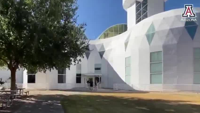ORACLE, Ariz. (KVOA) — Just about an hour out of Tucson is the world's largest controlled environment dedicated to understanding the impacts of climate change.
We're talking about the University of Arizona's Biosphere 2.
A two-year project inside Biosphere 2 that started in 1991, captured headlines around the world. While that experiment ended in 1993, the research at Biosphere 2 has continued through the years.
Biosphere 2 is 3.14 acres of science. Inside, human-made ecosystems are dedicated to helping us understand the future of our planet.
A world within walls, where habitats grow and research thrives, built to better understand how our Earth operates.
"We're doing things right here in Southern Arizona that give us greater insight into what's happening in the tropics, what's going to happen to our coral reefs, how our mangrove systems may or may not change," said John Adams, the Deputy Director with UArizona's Biosphere. "We have a rainforest, we have an ocean, we have a tropical savannah, we have a mangrove system."
In 1991, a group of eight with varied backgrounds closed an airtight door. That moment began a two-year experiment inside the facility that caught the world's attention.
"Fundamentally, the reason Biosphere 2 was originally built was to understand Earth's system," said Adams. "And that original experiment didn't go completely as they had planned. And so, a lot of people would refer to it as a failed experiment, but there's no such thing as a failed experiment because they learned a tremendous amount."
It's been 30 years since that group of eight exited Biosphere 2, but the research has not stopped. Researchers say the key is having control.
"You can control the temperature and experiment. Let it go to higher temperatures and see, can the plants actually withstand the higher temperatures or not," said Joost Van Haren, the Director of Rainforest Research.
As our planet continues to evolve, so does the facility. For example, adding lights to the ocean in preparation for experiments with climate change.
"Because corals get 60 percent of their food through photosynthesis, we wanted to make sure that we were not stressing them from a light perspective, so when we do change the water temperature or we change the water chemistry to look at how those corals deal with those changes, we know it's because of the change we're making and not the light limitations," said Adams.
Three decades after the original experiment, Biosphere 2 is still doing research that's the first of its kind.
"There's no place where you can test on a large scale the response of complex ecosystems. We can do it here at Biosphere 2," said Adams.
If you'd like to learn more about the research at Biosphere 2 or how to visit, you can click here.
SIGN UP: Sign Up For Our Email Alerts
APPS: Download Our News App
WATCH LIVE: Watch News 4 Tucson LIVE














